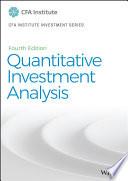QUANTITATIVE INVESTMENT ANALYSIS
FourthEdition
RichardA.DeFusco,CFA
DennisW.McLeavey,CFA
JeraldE.Pinto,CFA
DavidE.Runkle,CFA
Coverimage:©r.nagy/Shutterstock
Coverdesign:Wiley
Copyright©2004,2007,2015byCFAInstitute.Allrightsreserved.
PublishedbyJohnWiley&Sons,Inc.,Hoboken,NewJersey.
PublishedsimultaneouslyinCanada.
Nopartofthispublicationmaybereproduced,storedinaretrievalsystem,ortransmittedinanyformorbyany means,electronic,mechanical,photocopying,recording,scanning,orotherwise,exceptaspermittedunderSection 107or108ofthe1976UnitedStatesCopyrightAct,withouteitherthepriorwrittenpermissionofthePublisher, orauthorizationthroughpaymentoftheappropriateper-copyfeetotheCopyrightClearanceCenter,Inc.,222 RosewoodDrive,Danvers,MA01923,(978)750-8400,fax(978)646-8600,orontheWebatwww.copyright. com.RequeststothePublisherforpermissionshouldbeaddressedtothePermissionsDepartment,JohnWiley& Sons,Inc.,111RiverStreet,Hoboken,NJ07030,(201)748-6011,fax(201)748-6008,oronlineathttp://www. wiley.com/go/permissions.
LimitofLiability/DisclaimerofWarranty:Whilethepublisherandauthorhaveusedtheirbesteffortsinpreparing thisbook,theymakenorepresentationsorwarrantieswithrespecttotheaccuracyorcompletenessofthecontents ofthisbookandspecificallydisclaimanyimpliedwarrantiesofmerchantabilityorfitnessforaparticularpurpose. Nowarrantymaybecreatedorextendedbysalesrepresentativesorwrittensalesmaterials.Theadviceandstrategies containedhereinmaynotbesuitableforyoursituation.Youshouldconsultwithaprofessionalwhereappropriate. Neitherthepublishernorauthorshallbeliableforanylossofprofitoranyothercommercialdamages,including butnotlimitedtospecial,incidental,consequential,orotherdamages.
Forgeneralinformationonourotherproductsandservicesorfortechnicalsupport,pleasecontactourCustomer CareDepartmentwithintheUnitedStatesat(800)762-2974,outsidetheUnitedStatesat(317)572-3993,orfax (317)572-4002.
Wileypublishesinavarietyofprintandelectronicformatsandbyprint-on-demand.Somematerialincludedwith standardprintversionsofthisbookmaynotbeincludedine-booksorinprint-on-demand.Ifthisbookrefersto mediasuchasaCDorDVDthatisnotincludedintheversionyoupurchased,youmaydownloadthismaterialat http://booksupport.wiley.com.FormoreinformationaboutWileyproducts,visitwww.wiley.com.
ISBN978-1-119-74362-0(Hardcover) ISBN978-1-119-74365-1(ePDF) ISBN978-1-119-74364-4(ePub)
PrintedintheUnitedStatesofAmerica. 10987654321
CHAPTER1
TheTimeValueofMoney1 LearningOutcomes1
1.Introduction1
2.InterestRates:Interpretation2
3.TheFutureValueofaSingleCashFlow4
3.1.TheFrequencyofCompounding9
3.2.ContinuousCompounding11
3.3.StatedandEffectiveRates12
4.TheFutureValueofaSeriesofCashFlows13
4.1.EqualCashFlows OrdinaryAnnuity14
4.2.UnequalCashFlows15
5.ThePresentValueofaSingleCashFlow16
5.1.FindingthePresentValueofaSingleCashFlow16
5.2.TheFrequencyofCompounding18
6.ThePresentValueofaSeriesofCashFlows20
6.1.ThePresentValueofaSeriesofEqualCashFlows20
6.2.ThePresentValueofanInfiniteSeriesofEqualCashFlows Perpetuity24
6.3.PresentValuesIndexedatTimesOtherthant=025
6.4.ThePresentValueofaSeriesofUnequalCashFlows27
7.SolvingforRates,NumberofPeriods,orSizeofAnnuityPayments27
7.1.SolvingforInterestRatesandGrowthRates28
7.2.SolvingfortheNumberofPeriods30
7.3.SolvingfortheSizeofAnnuityPayments31
7.4.ReviewofPresentandFutureValueEquivalence35
7.5.TheCashFlowAdditivityPrinciple37
8.Summary38 PracticeProblems39
CHAPTER2
Organizing,Visualizing,andDescribingData45
LearningOutcomes45 1.Introduction45
2.DataTypes46
2.1.NumericalversusCategoricalData46
2.2.Cross-SectionalversusTime-SeriesversusPanelData49
2.3.StructuredversusUnstructuredData50
3.DataSummarization54
3.1.OrganizingDataforQuantitativeAnalysis54
3.2.SummarizingDataUsingFrequencyDistributions57
3.3.SummarizingDataUsingaContingencyTable63
4.DataVisualization68
4.1.HistogramandFrequencyPolygon68
4.2.BarChart69
4.3.Tree-Map73
4.4.WordCloud73
4.5.LineChart75
4.6.ScatterPlot77
4.7.HeatMap81
4.8.GuidetoSelectingamongVisualizationTypes82
5.MeasuresofCentralTendency85
5.1.TheArithmeticMean85
5.2.TheMedian90
5.3.TheMode92
5.4.OtherConceptsofMean92
6.OtherMeasuresofLocation:Quantiles102
6.1.Quartiles,Quintiles,Deciles,andPercentiles103
6.2.QuantilesinInvestmentPractice108
7.MeasuresofDispersion109
7.1.TheRange109
7.2.TheMeanAbsoluteDeviation109
7.3.SampleVarianceandSampleStandardDeviation111
7.4.TargetDownsideDeviation114
7.5.CoefficientofVariation117
8.TheShapeoftheDistributions:Skewness119
9.TheShapeoftheDistributions:Kurtosis121
10.CorrelationbetweenTwoVariables125
10.1.PropertiesofCorrelation126
10.2.LimitationsofCorrelationAnalysis129 11.Summary132 PracticeProblems135
CHAPTER3 ProbabilityConcepts147
LearningOutcomes147
1.Introduction148
2.Probability,ExpectedValue,andVariance148
3.PortfolioExpectedReturnandVarianceofReturn171
4.TopicsinProbability180
4.1.Bayes’ Formula180
4.2.PrinciplesofCounting184
5.Summary188 References190 PracticeProblem190
CHAPTER4 CommonProbabilityDistributions195
LearningOutcomes195
1.IntroductiontoCommonProbabilityDistributions196
2.DiscreteRandomVariables196
2.1.TheDiscreteUniformDistribution198
2.2.TheBinomialDistribution200
3.ContinuousRandomVariables210
3.1.ContinuousUniformDistribution210
3.2.TheNormalDistribution214
3.3.ApplicationsoftheNormalDistribution220
3.4.TheLognormalDistribution222
4.IntroductiontoMonteCarloSimulation228
5.Summary231 References233 PracticeProblems234
CHAPTER5 SamplingandEstimation241
LearningOutcomes241
1.Introduction242
2.Sampling242
2.1.SimpleRandomSampling242
2.2.StratifiedRandomSampling244
2.3.Time-SeriesandCross-SectionalData245
3.DistributionoftheSampleMean248
3.1.TheCentralLimitTheorem248
4.PointandIntervalEstimatesofthePopulationMean251
4.1.PointEstimators252
4.2.ConfidenceIntervalsforthePopulationMean253
4.3.SelectionofSampleSize259
5.MoreonSampling261
5.1.Data-MiningBias261
5.2.SampleSelectionBias264
5.3.Look-AheadBias265
5.4.Time-PeriodBias266
6.Summary267 References269 PracticeProblems270
CHAPTER6
HypothesisTesting275
LearningOutcomes275
1.Introduction276
2.HypothesisTesting277
3.HypothesisTestsConcerningtheMean287
3.1.TestsConcerningaSingleMean287
3.2.TestsConcerningDifferencesbetweenMeans294
3.3.TestsConcerningMeanDifferences299
4.HypothesisTestsConcerningVarianceandCorrelation303
4.1.TestsConcerningaSingleVariance303
4.2.TestsConcerningtheEquality(Inequality)ofTwoVariances305
4.3.TestsConcerningCorrelation308
5.OtherIssues:NonparametricInference310
5.1.NonparametricTestsConcerningCorrelation:TheSpearman RankCorrelationCoefficient312
5.2.NonparametricInference:Summary313
6.Summary314 References317 PracticeProblems317
CHAPTER7
IntroductiontoLinearRegression327
LearningOutcomes327
1.Introduction328
2.LinearRegression328
2.1.LinearRegressionwithOneIndependentVariable328
3.AssumptionsoftheLinearRegressionModel332
4.TheStandardErrorofEstimate335
5.TheCoefficientofDetermination337
6.HypothesisTesting339
7.AnalysisofVarianceinaRegressionwithOneIndependentVariable347
8.PredictionIntervals350
9.Summary353 References354 PracticeProblems354
CHAPTER8
MultipleRegression365
LearningOutcomes365
1.Introduction366
2.MultipleLinearRegression366
2.1.AssumptionsoftheMultipleLinearRegressionModel372
2.2.PredictingtheDependentVariableinaMultiple RegressionModel376
2.3.TestingWhetherAllPopulationRegressionCoefficients EqualZero378
2.4.Adjusted R2 380
3.UsingDummyVariablesinRegressions381
3.1.DefiningaDummyVariable381
3.2.VisualizingandInterpretingDummyVariables382
3.3.TestingforStatisticalSignificance384
4.ViolationsofRegressionAssumptions387
4.1.Heteroskedasticity388
4.2.SerialCorrelation394
4.3.Multicollinearity398
4.4.Heteroskedasticity,SerialCorrelation,Multicollinearity: SummarizingtheIssues401
5.ModelSpecificationandErrorsinSpecification401
5.1.PrinciplesofModelSpecification402
5.2.MisspecifiedFunctionalForm402
5.3.Time-SeriesMisspecification(IndependentVariables CorrelatedwithErrors)410
5.4.OtherTypesofTime-SeriesMisspecification414
6.ModelswithQualitativeDependentVariables414
6.1.ModelswithQualitativeDependentVariables414
7.Summary422 References425 PracticeProblems426
CHAPTER9
Time-SeriesAnalysis451
LearningOutcomes451
1.IntroductiontoTime-SeriesAnalysis452
2.ChallengesofWorkingwithTimeSeries454
3.TrendModels454
3.1.LinearTrendModels455
3.2.Log-LinearTrendModels458
3.3.TrendModelsandTestingforCorrelatedErrors463
4.Autoregressive(AR)Time-SeriesModels464
4.1.Covariance-StationarySeries465
4.2.DetectingSeriallyCorrelatedErrorsinanAutoregressiveModel466
4.3.MeanReversion469
4.4.MultiperiodForecastsandtheChainRuleofForecasting470
4.5.ComparingForecastModelPerformance473
4.6.InstabilityofRegressionCoefficients475
5.RandomWalksandUnitRoots478
5.1.RandomWalks478
5.2.TheUnitRootTestofNonstationarity482
6.Moving-AverageTime-SeriesModels486
6.1.SmoothingPastValueswithan n-PeriodMovingAverage486
6.2.Moving-AverageTime-SeriesModelsforForecasting489
7.SeasonalityinTime-SeriesModels491
8.AutoregressiveMoving-AverageModels496
9.AutoregressiveConditionalHeteroskedasticityModels497
10.RegressionswithMorethanOneTimeSeries500
11.OtherIssuesinTimeSeries504
12.SuggestedStepsinTime-SeriesForecasting505 13.Summary507 References508 PracticeProblems509
CHAPTER10
MachineLearning527
LearningOutcomes527
1.Introduction527
2.MachineLearningandInvestmentManagement528
3.WhatisMachineLearning?529
3.1.DefiningMachineLearning529
3.2.SupervisedLearning529
3.3.UnsupervisedLearning531
3.4.DeepLearningandReinforcementLearning531
3.5.SummaryofMLAlgorithmsandHowtoChooseamongThem532
4.OverviewofEvaluatingMLAlgorithmPerformance533
4.1.GeneralizationandOverfitting534
4.2.ErrorsandOverfitting534
4.3.PreventingOverfittinginSupervisedMachineLearning537
5.SupervisedMachineLearningAlgorithms539
5.1.PenalizedRegression539
5.2.SupportVectorMachine541
5.3. K-NearestNeighbor542
5.4.ClassificationandRegressionTree544
5.5.EnsembleLearningandRandomForest547
6.UnsupervisedMachineLearningAlgorithms559
6.1.PrincipalComponentsAnalysis560
6.2.Clustering563
7.NeuralNetworks,DeepLearningNets,andReinforcementLearning575
7.1.NeuralNetworks575
7.2.DeepLearningNeuralNetworks578
7.3.ReinforcementLearning579
8.ChoosinganAppropriateMLAlgorithm589 9.Summary590 References593 PracticeProblems593
CHAPTER11
BigDataProjects597
LearningOutcomes597
1.Introduction597
2.BigDatainInvestmentManagement598
3.StepsinExecutingaDataAnalysisProject:FinancialForecasting withBigData599
4.DataPreparationandWrangling603
4.1.StructuredData604
4.2.Unstructured(Text)Data610
5.DataExplorationObjectivesandMethods617
5.1.StructuredData618
5.2.UnstructuredData:TextExploration622
6.ModelTraining629
6.1.StructuredandUnstructuredData630
7.FinancialForecastingProject:ClassifyingandPredicting SentimentforStocks639
7.1.TextCuration,Preparation,andWrangling640
7.2.DataExploration644
7.3.ModelTraining654
7.4.ResultsandInterpretation658
8.Summary664 PracticeProblems665
CHAPTER12
UsingMultifactorModels675
LearningOutcomes675
1.Introduction675
2.MultifactorModelsandModernPortfolioTheory676
3.ArbitragePricingTheory677
4.MultifactorModels:Types683
4.1.FactorsandTypesofMultifactorModels683
4.2.TheStructureofMacroeconomicFactorModels684
4.3.TheStructureofFundamentalFactorModels687
4.4.Fixed-IncomeMultifactorModels691
5.MultifactorModels:SelectedApplications695
5.1.FactorModelsinReturnAttribution696
5.2.FactorModelsinRiskAttribution698
5.3.FactorModelsinPortfolioConstruction703
5.4.HowFactorConsiderationsCanBeUsefulinStrategic PortfolioDecisions705 6.Summary706 References707 PracticeProblems708
CHAPTER13
MeasuringandManagingMarketRisk713
LearningOutcomes713
1.Introduction714
2.UnderstandingValueatRisk714
2.1.ValueatRisk:FormalDefinition715
2.2.EstimatingVaR718
2.3.AdvantagesandLimitationsofVaR730
2.4.ExtensionsofVaR733
3.OtherKeyRiskMeasures SensitivityandScenarioMeasures735
3.1.SensitivityRiskMeasures736
3.2.ScenarioRiskMeasures740
3.3.SensitivityandScenarioRiskMeasuresandVaR746
4.UsingConstraintsinMarketRiskManagement750
4.1.RiskBudgeting751
4.2.PositionLimits752
4.3.ScenarioLimits752
4.4.Stop-LossLimits753
4.5.RiskMeasuresandCapitalAllocation753
5.ApplicationsofRiskMeasures755
5.1.MarketParticipantsandtheDifferentRiskMeasuresTheyUse755
6.Summary764 References766 PracticeProblems766
CHAPTER14
BacktestingandSimulation775
LearningOutcomes775
1.Introduction775
2.TheObjectivesofBacktesting776
3.TheBacktestingProcess776
3.1.StrategyDesign777
3.2.RollingWindowBacktesting778
3.3.KeyParametersinBacktesting779
3.4.Long/ShortHedgedPortfolioApproach781
3.5.PearsonandSpearmanRankIC785
3.6.UnivariateRegression789
3.7.DoDifferentBacktestingMethodologiesTelltheSameStory?789
4.MetricsandVisualsUsedinBacktesting792
4.1.Coverage792
4.2.Distribution794
4.3.PerformanceDecay,StructuralBreaks,andDownsideRisk797
4.4.FactorTurnoverandDecay797
5.CommonProblemsinBacktesting801
5.1.SurvivorshipBias801
5.2.Look-AheadBias804
6.BacktestingFactorAllocationStrategies807
6.1.SettingtheScene808
6.2.BacktestingtheBenchmarkandRiskParityStrategies808
7.ComparingMethodsofModelingRandomness813
7.1.FactorPortfoliosandBMandRPAllocationStrategies814
7.2.FactorReturnStatisticalProperties815
7.3.PerformanceMeasurementandDownsideRisk819
7.4.MethodstoAccountforRandomness821
8.ScenarioAnalysis824
9.HistoricalSimulationversusMonteCarloSimulation828
10.HistoricalSimulation830
11.MonteCarloSimulation835
12.SensitivityAnalysis840
13.Summary848 References849 PracticeProblems849
2QuantitativeInvestmentAnalysis
accurately,wemustunderstandthemathematicsoftimevalueofmoneyproblems.Money hastimevalueinthatindividualsvalueagivenamountofmoneymorehighlytheearlieritis received.Therefore,asmalleramountofmoneynowmaybeequivalentinvaluetoalarger amountreceivedatafuturedate.The timevalueofmoney asatopicininvestment mathematicsdealswithequivalencerelationshipsbetweencashflowswithdifferentdates. Masteryoftimevalueofmoneyconceptsandtechniquesisessentialforinvestmentanalysts.
Thechapter1 isorganizedasfollows:Section2introducessometerminologyused throughoutthechapterandsuppliessomeeconomicintuitionforthevariableswewill discuss.Section3tacklestheproblemofdeterminingtheworthatafuturepointintimeofan amountinvestedtoday.Section4addressesthefutureworthofaseriesofcashflows.These twosectionsprovidethetoolsforcalculatingtheequivalentvalueatafuturedateofasingle cashfloworseriesofcashflows.Sections5and6discusstheequivalentvaluetodayofasingle futurecashflowandaseriesoffuturecashflows,respectively.InSection7,weexplorehowto determineotherquantitiesofinterestintimevalueofmoneyproblems.
2.INTERESTRATES:INTERPRETATION
Inthischapter,wewillcontinuallyrefertointerestrates.Insomecases,weassumea particularvaluefortheinterestrate;inothercases,theinterestratewillbetheunknown quantityweseektodetermine.Beforeturningtothemechanicsoftimevalueofmoney problems,wemustillustratetheunderlyingeconomicconcepts.Inthissection,webriefly explainthemeaningandinterpretationofinterestrates.
Timevalueofmoneyconcernsequivalencerelationshipsbetweencashflowsoccurringon differentdates.Theideaofequivalencerelationshipsisrelativelysimple.Considerthe followingexchange:Youpay$10,000todayandinreturnreceive$9,500today.Wouldyou acceptthisarrangement?Notlikely.Butwhatifyoureceivedthe$9,500todayandpaidthe $10,000oneyearfromnow?Cantheseamountsbeconsideredequivalent?Possibly,because apaymentof$10,000ayearfromnowwouldprobablybeworthlesstoyouthanapayment of$10,000today.Itwouldbefair,therefore,to discount the$10,000receivedinoneyear; thatis,tocutitsvaluebasedonhowmuchtimepassesbeforethemoneyispaid.An interest rate,denoted r,isarateofreturnthatreflectstherelationshipbetweendifferentlydatedcash flows.If$9,500todayand$10,000inoneyearareequivalentinvalue,then$10,000 $9,500 ¼ $500istherequiredcompensationforreceiving$10,000inoneyearratherthan now.Theinterestrate therequiredcompensationstatedasarateofreturn is$500/ $9,500 ¼ 0.0526or5.26percent.
Interestratescanbethoughtofinthreeways.First,theycanbeconsideredrequiredrates ofreturn thatis,theminimumrateofreturnaninvestormustreceiveinordertoacceptthe investment.Second,interestratescanbeconsidereddiscountrates.Intheexampleabove, 5.26percentisthatrateatwhichwediscountedthe$10,000futureamounttofinditsvalue today.Thus,weusetheterms “interestrate” and “discountrate” almostinterchangeably. Third,interestratescanbeconsideredopportunitycosts.An opportunitycost isthevalue thatinvestorsforgobychoosingaparticularcourseofaction.Intheexample,ifthepartywho supplied$9,500hadinsteaddecidedtospendittoday,hewouldhaveforgoneearning
1Examplesinthis,andotherchapters,inthetextwereupdatedbyProfessorSanjivSabherwalofthe UniversityofTexas,Arlington.
5.26percentonthemoney.Sowecanview5.26percentastheopportunitycostofcurrent consumption.
Economicstellsusthatinterestratesaresetinthemarketplacebytheforcesofsupply anddemand,whereinvestorsaresuppliersoffundsandborrowersaredemandersoffunds. Takingtheperspectiveofinvestorsinanalyzingmarket-determinedinterestrates,wecanview aninterestrate r asbeingcomposedofarealrisk-freeinterestrateplusasetoffourpremiums thatarerequiredreturnsorcompensationforbearingdistincttypesofrisk:
r ¼ Realrisk-freeinterestrate þ Inflationpremium þ Defaultriskpremium þ Liquiditypremium þ Maturitypremium
• The realrisk-freeinterestrate isthesingle-periodinterestrateforacompletelyrisk-free securityifnoinflationwereexpected.Ineconomictheory,therealrisk-freeratereflectsthe timepreferencesofindividualsforcurrentversusfuturerealconsumption.
• The inflationpremium compensatesinvestorsforexpectedinflationandreflectstheaverage inflationrateexpectedoverthematurityofthedebt.Inflationreducesthepurchasingpower ofaunitofcurrency theamountofgoodsandservicesonecanbuywithit.Thesumof therealrisk-freeinterestrateandtheinflationpremiumisthe nominalrisk-freeinterest rate 2 Manycountrieshavegovernmentalshort-termdebtwhoseinterestratecanbe consideredtorepresentthenominalrisk-freeinterestrateinthatcountry.Theinterestrate ona90-dayUSTreasurybill(T-bill),forexample,representsthenominalrisk-freeinterest rateoverthattimehorizon.3 UST-billscanbeboughtandsoldinlargequantitieswith minimaltransactioncostsandarebackedbythefullfaithandcreditoftheUSgovernment.
• The defaultriskpremium compensatesinvestorsforthepossibilitythattheborrowerwill failtomakeapromisedpaymentatthecontractedtimeandinthecontractedamount.
• The liquiditypremium compensatesinvestorsfortheriskoflossrelativetoaninvestment’ s fairvalueiftheinvestmentneedstobeconvertedtocashquickly.UST-bills,forexample, donotbearaliquiditypremiumbecauselargeamountscanbeboughtandsoldwithout affectingtheirmarketprice.Manybondsofsmallissuers,bycontrast,tradeinfrequentlyafter theyareissued;theinterestrateonsuchbondsincludesaliquiditypremiumreflectingthe relativelyhighcosts(includingtheimpactonprice)ofsellingaposition.
• The maturitypremium compensatesinvestorsfortheincreasedsensitivityofthemarket valueofdebttoachangeinmarketinterestratesasmaturityisextended,ingeneral (holdingallelseequal).Thedifferencebetweentheinterestrateonlonger-maturity,liquid Treasurydebtandthatonshort-termTreasurydebtreflectsapositivematuritypremium forthelonger-termdebt(andpossiblydifferentinflationpremiumsaswell).
2Technically,1plusthenominalrateequalstheproductof1plustherealrateand1plustheinflationrate. Asaquickapproximation,however,thenominalrateisequaltotherealrateplusaninflationpremium.In thisdiscussionwefocusonapproximateadditiverelationshipstohighlighttheunderlyingconcepts.
3OtherdevelopedcountriesissuesecuritiessimilartoUSTreasurybills.TheFrenchgovernmentissues BTFsornegotiablefixed-ratediscountTreasurybills(BonsduTrésoràtauxfixeetàintérêtsprécomptés)with maturitiesofuptooneyear.TheJapanesegovernmentissuesashort-termTreasurybillwithmaturitiesof6 and12months.TheGermangovernmentissuesatdiscountbothTreasuryfinancingpaper (FinanzierungsschätzedesBundes or,forshort, Schätze)andTreasurydiscountpaper(Bubills)with maturitiesupto24months.IntheUnitedKingdom,theBritishgovernmentissuesgilt-edgedTreasury billswithmaturitiesrangingfrom1to364days.TheCanadiangovernmentbondmarketiscloselyrelated totheUSmarket;CanadianTreasurybillshavematuritiesof3,6,and12months.
Usingthisinsightintotheeconomicmeaningofinterestrates,wenowturntoadiscussionof solvingtimevalueofmoneyproblems,startingwiththefuturevalueofasinglecashflow.
3.THEFUTUREVALUEOFASINGLECASHFLOW
Inthissection,weintroducetimevalueassociatedwithasinglecashfloworlump-sum investment.Wedescribetherelationshipbetweenaninitialinvestmentor presentvalue (PV),whichearnsarateofreturn(theinterestrateperperiod)denotedas r, andits future value(FV),whichwillbereceived N yearsorperiodsfromtoday.
Thefollowingexampleillustratesthisconcept.Supposeyouinvest$100(PV ¼ $100)in aninterest-bearingbankaccountpaying5percentannually.Attheendofthefirstyear,you willhavethe$100plustheinterestearned,0.05 $100 ¼ $5,foratotalof$105.To formalizethisone-periodexample,wedefinethefollowingterms:
PV ¼ presentvalueoftheinvestment
FVN ¼ futurevalueoftheinvestment N periodsfromtoday r ¼ rateofinterestperperiod
For N ¼ 1,theexpressionforthefuturevalueofamountPVis
¼ PV(1 þ r)(1)
Forthisexample,wecalculatethefuturevalueoneyearfromtodayasFV1 ¼ $100(1.05) ¼ $105.
Nowsupposeyoudecidetoinvesttheinitial$100fortwoyearswithinterestearnedand creditedtoyouraccountannually(annualcompounding).Attheendofthefirstyear(the beginningofthesecondyear),youraccountwillhave$105,whichyouwillleaveinthebank foranotheryear.Thus,withabeginningamountof$105(PV ¼ $105),theamountatthe endofthesecondyearwillbe$105(1.05) ¼ $110.25.Notethatthe$5.25interestearned duringthesecondyearis5percentoftheamountinvestedatthebeginningofYear2.
Anotherwaytounderstandthisexampleistonotethattheamountinvestedatthe beginningofYear2iscomposedoftheoriginal$100thatyouinvestedplusthe$5interest earnedduringthefirstyear.Duringthesecondyear,theoriginalprincipalagainearnsinterest,as doestheinterestthatwasearnedduringYear1.Youcanseehowtheoriginalinvestmentgrows: The$5interestthatyouearnedeachperiodonthe$100originalinvestmentisknownas simple interest (theinterestratetimestheprincipal). Principal istheamountoffundsoriginally Originalinvestment$100.00
Interestforthefirstyear($100 0.05)5.00
Interestforthesecondyearbasedonoriginalinvestment($100 0.05)5.00
Interestforthesecondyearbasedoninterestearnedinthefirstyear(0.05 $5.00 interestoninterest) 0.25
Total $110.25
FV1













